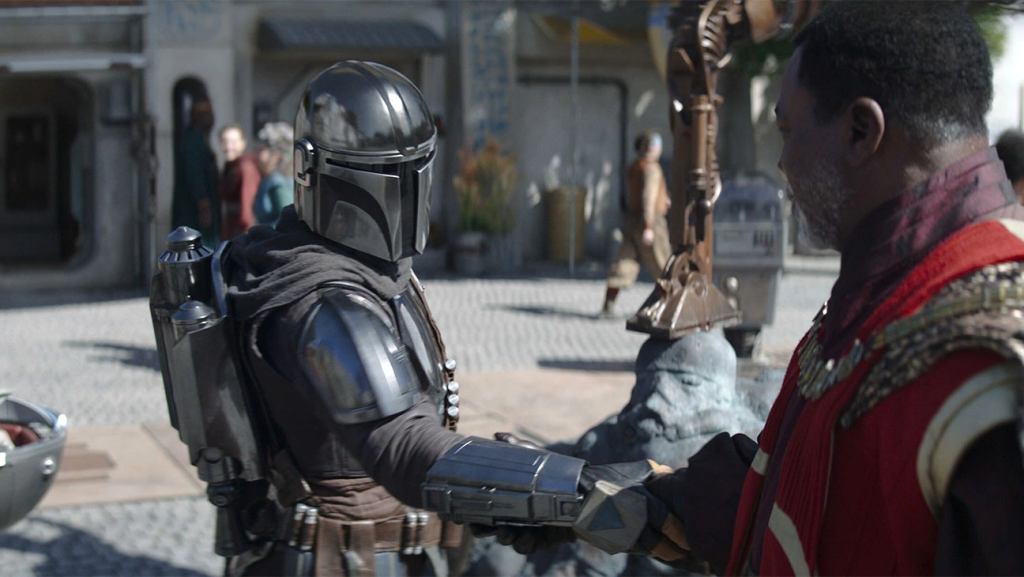This is the way. Since 2019, “The Mandalorian” has delivered “Star Wars” fans with high quality content centered around the Mandalorian himself, Din Djarin, and his adopted child Grogu — two lovable characters that make for quite the dynamic duo. However, the second season of the show started a trend of cameo appearances and connections to the larger “Star Wars” universe, for better or worse.
Season three extends this further, with an overarching storyline of Djarin and his colleague Bo-Katan Kryze attempting to reclaim the planet of Mandalore for their creed. This goal guides most of the season, with some episodes being side quests for the characters on their journey and a few focusing on different characters entirely. While season three has moments that are on par with the previous two excellent seasons of the show, there are more low moments that make it the weakest season yet.
Starting with the positives, the episode titles are creative and add to the show. Each episode is titled “The …,” such as the first episode being “Chapter 17: The Apostate.” The titles are cleverly named so that there are often multiple meanings. For instance, the apostate of Chapter 17 could be Djarin or Kryze, as both have been exiled from their respective Mandalorian sects. “Chapter 20: The Foundling” could also refer to Grogu or the young Mandalorian kidnapped by a vicious raptor. The dual meanings of the titles make the episodes more exciting, as the audience has to try and guess what the title could be referring to. Furthermore, the title of the show, “The Mandalorian,” could refer to Djarin, Kryze or even Grogu as he starts his Mandalorian training.
The visuals of the show are likewise stunning and are much better than they have any right to be for a streaming service show. From the physical sets to the virtual backdrops and intricate beasts, every shot in the show is carefully crafted and holds up to scrutiny from the viewer. The highlights include the raptor from Chapter 20, Zeb Orrelios in Chapter 21 and the planet of Plazir-15 in Chapter 22. The visual effects make the show entertaining and watchable, even when the story is frustrating.
Similarly, Ludwig Göransson’s score for “The Mandalorian” is as superb as it is in the first two seasons. The highlights of the music are when the main Mandalorian theme plays, which happens about once an episode, just enough to excite the viewer but not enough to spoil the theme. The show also utilizes the New Republic theme from the “Star Wars” sequel trilogy, helping to bridge the gap between the original and new “Star Wars” films.
What holds back season three of “The Mandalorian” from greatness is the disjointed story. Although there is an overarching plotline in the season, many of the episodes are disconnected and seemingly forget about the main objectives of the show.
Perhaps the worst offender is “Chapter 19: The Convert,” as the vast majority of the episode is spent on Dr. Pershing and Elia Kane, former imperial officers now working for the New Republic. While their story is interesting, it is a waste for a show called “The Mandalorian” to basically spend an entire episode on third-string characters. Not every episode has to be impactful to the “Star Wars” universe, but they should all at least develop the characters of Djarin and Grogu in some way.
Another related problem is that the individual stories of each episode do not always connect to each other in satisfying ways. For instance, the most egregious example of this is that the first episode of the season introduces the arc of Djarin attempting to revive his old droid companion, IG-11. This plot point is then ignored for five straight episodes without being mentioned, making it feel as though the season lacks a unified vision.
On the whole, the eight episodes of the third season of “The Mandalorian” are incredibly hit or miss, lacking the near perfect consistency that originally defined the show. The worst episodes of the season are “Chapter 19: The Convert” and “Chapter 22: Guns for Hire” as they focus too much on side characters and quests not fully related to the main story. On the other hand, the best episodes are the last two, “Chapter 23: The Spies” and “Chapter 24: The Return” as the Mandalorians fight for their homeland against the charmingly evil Moff Gideon.
The best way to summarize season three of “The Mandalorian” is that it is disappointingly inconsistent. While some episodes are sure to please “Star Wars” fans, many leave something to be desired. As the fourth season of the show has been officially confirmed, hopefully it remedies some of the problems of its preceding season.
Rating: 2.75 out of 5 stars



